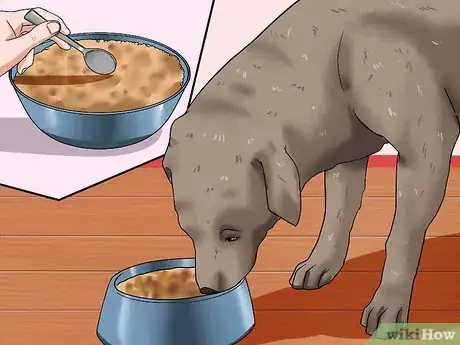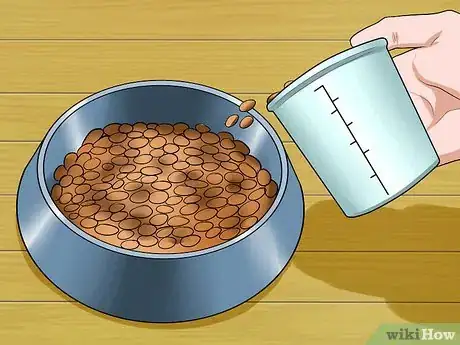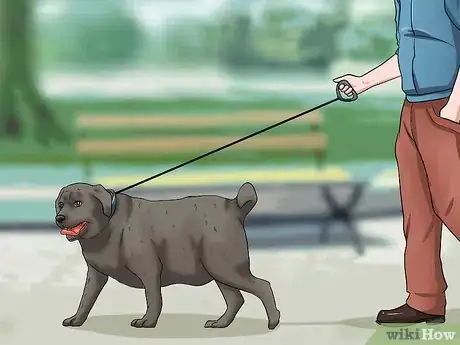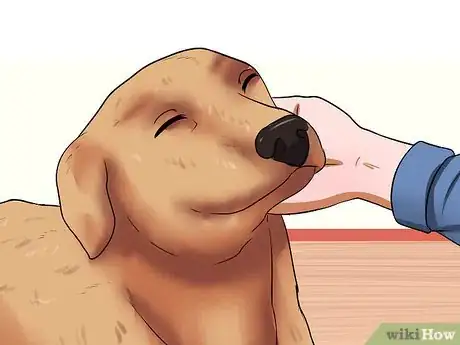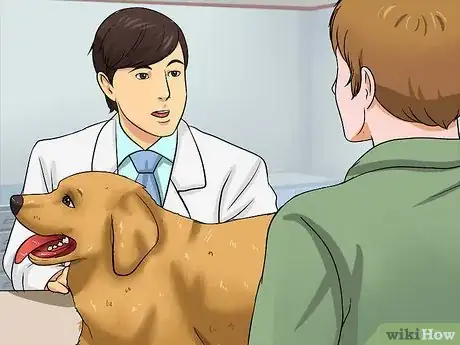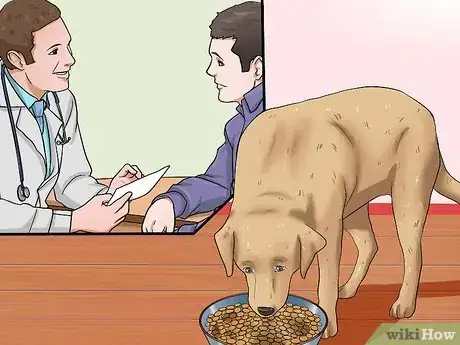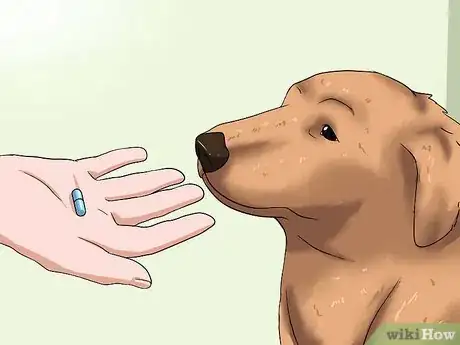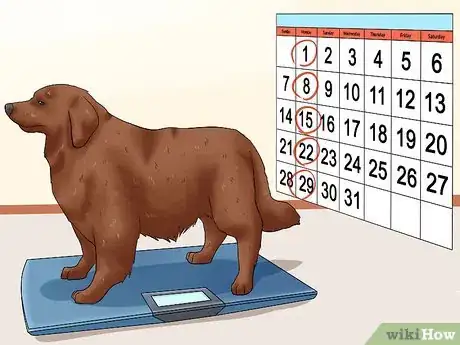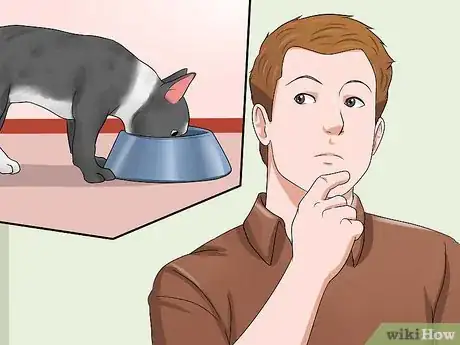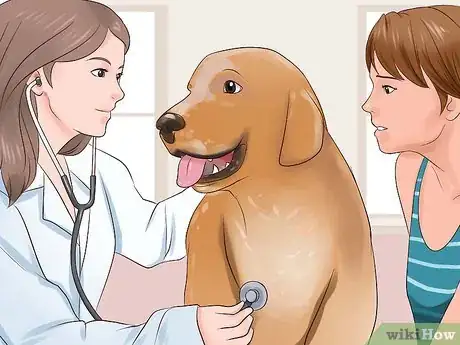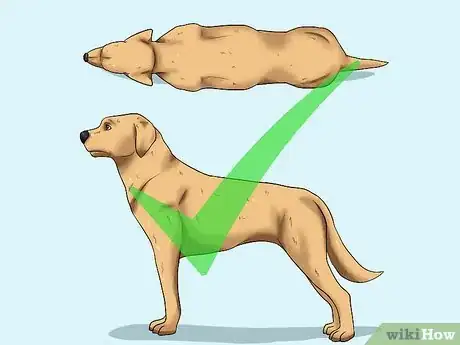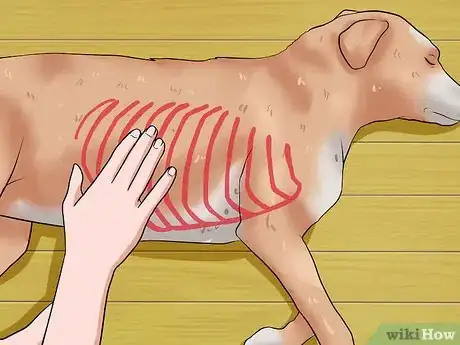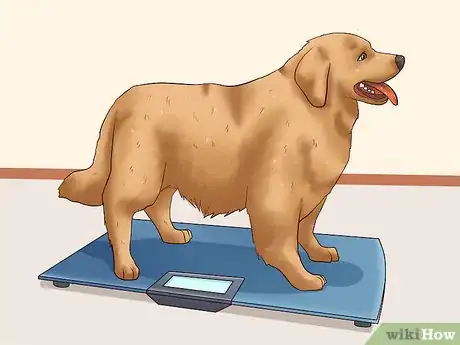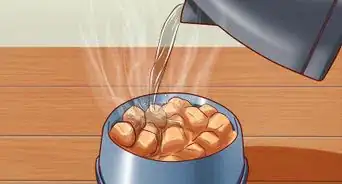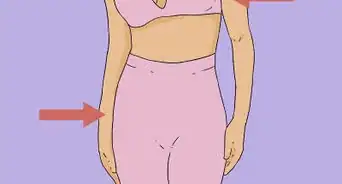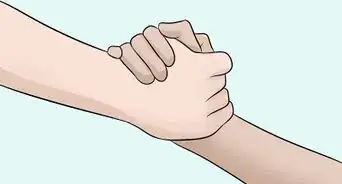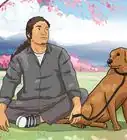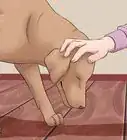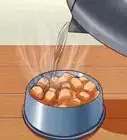This article was co-authored by Star of Texas Veterinary Hospital. Star of Texas Veterinary Hospital is a team of four veterinarians based in Austin, Texas. Star of Texas Veterinary Hospital offers medical assessments, dentistry, ultrasonography, flea control, radiology, and cardiology services to dogs, cats, and pocket pets. Star of Texas Veterinary Hospital is Austin’s first Fear Free Certified Practice and was awarded "1st Runner Up in Culture" by the 2020 Best of the Best Austin Official Choice Awards. They were a Best of the Best winner in Austin's Official Community Choice Awards. Star of Texas Veterinary Hospital's veterinarians are members of the American Association of Feline Practitioners, the Texas Veterinary Medical Association, and the American Veterinary Medical Association.
There are 12 references cited in this article, which can be found at the bottom of the page.
wikiHow marks an article as reader-approved once it receives enough positive feedback. This article has 13 testimonials from our readers, earning it our reader-approved status.
This article has been viewed 627,414 times.
A 2018 study shows the median lifespan of overweight dogs is about 2.5 years shorter than that of dogs at healthy weights.[1] Dogs that are overweight are more susceptible to illnesses, such as diabetes, heart disease, cancer, and other debilitating problems. By carrying too much weight on its body, a dog that is overweight is also putting extra strain on its joints and backs, which can lead to arthritis. If your dog is overweight, it's in your and your dog's best interest to get it slimmed down as soon as possible.
Steps
Following a Weight-Loss Plan
-
1Feed your dog a specialized diet for weight loss. Your veterinarian can help you decide what to feed your dog. This can be simply reducing the amount of your dog's current food or changing it to a weight loss diet.
- There are prescription diets available to help your dog lose weight along with diets to help them keep it off once they have reached their ideal weight. These diets are lower in calories and contain higher amounts of fiber to make your dog feel full while taking in fewer calories. These diets are typically more expensive than regular foods and are usually reserved for cases where extreme weight loss is needed or where simply reducing the amount of a regular food isn't working.
- There is now a new category of weight loss diets available, which work by using "genomics" or using science to switch on genes concerned with burning calories. Hills Metabolic diet is the only variety currently on the market.
-
2Measure out your dog's food for each feeding. This allows you to easily spot any changes in appetite, which can indicate other issues. This is even more important when trying to get your dog to lose weight. You need to know exactly what and how much your dog is eating in order to be able to gauge how effective your plan is and to make any needed adjustments.
- If you have other dog's in the house you may need to keep your pups separated during feeding time. Make sure that each dog only gets its own food by placing them in separate rooms with their meals until all food it consumed.
Advertisement -
3Keep a daily record of how much you're feeding your dog, including treats, and the amount of exercise they are getting. You can use a measuring cup, but weighing each day’s amount is a more accurate way to be sure you are feeding the right amount.
- You can make a chart or download one from the Internet. Be sure to also include a weekly weight for your dog. Take it with you when you visit your vet to best evaluate your progress. [2]
-
4Reduce, or eliminate, unhealthy treats. Most commercial treats for dogs are very high in calories, similar to the candy that people eat. While there are reduced calorie commercial treats, you can almost eliminate your dog's treat calories by replacing them with much healthier snacks.[3]
- Examples of healthier snacks that are safe for dogs include carrots, green beans, broccoli, celery, and apples.[4] As with any diet plan, these should be limited.
- Always consider any known food allergies before giving your dog anything new to their diet and also be aware that some human foods can be toxic to dogs and should be avoided.
- When feeding treats, don't forget to include them in the total amount of daily calories. You may need to decrease the amount of calories from other sources to compensate.
- As a rule treats should make up no more than 10% of the total daily diet.
- You can also put some of your dog's daily kibble allowance in a container and use this as a treat throughout the day.
-
5Exercise your dog more often. Exercise will improve your dog's muscle tone, metabolism, and weight. The sum of your dog's weight is simple math. The number of calories consumed in their diet minus the number of calories used during their day, will determine whether they will lose weight or not. By developing an exercise routine, you will improve your dog's metabolism and overall health.
- This should be a major point of discussion with your vet before starting regular exercise. Some breeds are naturally unable to perform certain types and intensities of exercise. Also, depending on your dog's overall physical condition and the environment the exercise will take place in, you may need to be very careful about what you encourage your dog to do.
- Typically, starting with short walks and then gradually increasing the distance and/or the speed of the walks, depending on what your dog can tolerate, is a simple way to implement an exercise routine. Try taking them on new routes to keep things interesting for both you and your dog.[5] This can be combined with playing games like fetch or just being active with them and their toys for 20 minutes a day.[6]
- If you don't have time to walk your dog, consider taking it to a doggy daycare or hiring a dog walker.[7]
-
6Make sure your dog gets mental stimulation. You may be surprised to learn that mental stimulation can be just as important as physical exercise when trying to help your dog lose weight. Many dogs overeat either to get attention (they pester their owner for attention and the owner thinks they are hungry) or because they are bored.
- Try grooming your dog or playing when they ask for attention instead of immediately feeding them.
- In addition, use puzzle feeders instead of putting a bowl of food down. This makes the dog problem-solve to get their meal, which makes it more difficult to overeat. There are lots of commercial puzzle feeders available, but also consider simple strategies such as scattering the dog's kibble in the grass, or putting their food inside a cardboard box.
Developing A Weight-Loss Plan
-
1Visit your veterinarian. Once you've determined that your dog is overweight, or if you're still unsure, it's time for a visit to your vet. Your vet can evaluate your dog's weight, discuss possible causes, and give you an idea of how much weight your dog needs to lose or at least an initial goal.
-
2Develop a meal plan with your veterinarian. Your vet can also help you with a specific weight loss plan to get your dog to where they need to be. This may include changing to a dog food designed for weight loss, recommendations on what to feed as treats, adjusting the portion size and frequency of feedings, and increasing the amount of exercise.
- Your vet can also evaluate if there are any health reasons for not starting such a plan. [8]
-
3Consider weight loss drugs in extreme cases. There are now also drugs, specifically for dogs, that are available to aid in weight loss. These drugs basically work by causing a decrease in appetite. Be aware that these are known to cause a high rate of side effects, such as vomiting and diarrhea.[9]
- They should only be used as a last resort, in dogs that are otherwise healthy, and only after ruling out all medical issues that can be a cause for both your dog being overweight and their inability to lose weight.
- Your veterinarian can determine if your dog is an acceptable candidate for this option.
Monitoring and Adjusting the Weight-Loss Plan
-
1Monitor your dog's weight at least once a week. Buy a canine scale, or use whatever weighing process you used before, and make a chart. Chart your dog's weight to see what progress has been made.
- Your dog should also be weighed monthly by the vet until she or he is the ideal weight.
-
2Evaluate whether your weigh-loss plan is extreme enough. If you're restricting your dog's caloric intake and making sure they are getting enough exercise, but still not getting the results that you expect, consult with your veterinarian again.[10] There may be a need for further calorie restriction, and/or a need to increase the amount of exercise.
- Your initial plan, while developed with you vet, may not be perfect for your pet's needs. Feel free to change it, with the help and advisement of your vet, if it's not working.
-
3Think about ways your dog might be getting additional calories. There are several possible, non-medical reasons why your dog is unable to lose weight. These can include someone else in the household giving extra food or treats without you knowing about it or the dog getting into food supplies.
-
4Consider medical issues may be a cause. There are some medical issues that can cause weight gain and also make it very difficult, to impossible, for your dog to lose weight. For example, Hypothyroidism prevents your dog from burning calories like they should while also decreasing their desire to be active. This is a double whammy when it comes to weight control.
- Diabetes and Cushing's disease are also medical reasons that can prevent your dog from losing weight.
Determining If Your Dog Is Overweight
-
1Evaluate how your dog looks. Because of the varying body types between dogs of the same breed, what your dog looks like is actually the ultimate test of whether it is overweight or not. Checking its profile from both the top and the side will give you a good idea of your dog's current condition.
- When standing above your dog and looking directly down at their back you should see an obvious waist in front of the rear legs and a definite difference between the chest and the abdomen. [11]
- When looking at your dog from the side, you should be able so see a difference between the size of the chest and abdomen. Your dog should have a waist that is easily noticeable and its abdomen should be closer to its spine than its chest. [12]
- A broad, flat back and a sagging abdomen can indicate that a dog is overweight.[13]
-
2Do a "rib test" on your dog.[14] Another method for evaluating your dog's weight is the "rib test". Put your hands on either side of your dog's chest and feel for their ribs. In a normal weight dog, you should not be able to see their ribs, but you should be able to easily feel and count each individual rib. If you can't do this easily, it is a sign that your dog is overweight.[15]
-
3Weigh your dog. There are several good charts available on the internet that give an ideal weight range based on your dog's breed. Keep in mind that these ranges are based on averages and what's typical for each breed listed. Each dog should ultimately be evaluated as an individual.
- Depending on its size you may be able to get an accurate weight at home. If you want to weigh your dog at home, first weigh yourself and then pick up your dog (if you can) and weigh you and your dog together. By subtracting your weight from the what you both weighed together you will get your dog's weight.[16] Always use the same method for weighing to keep the results as accurate as possible.
- A visit to your vet is a great time to easily get an accurate weight and also get their recommendations on a healthy weight for your dog.
Expert Q&A
-
QuestionDoes walking your dog help it lose weight?
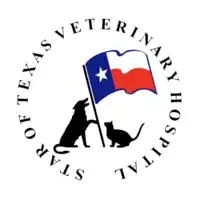 Star of Texas Veterinary HospitalStar of Texas Veterinary Hospital is a team of four veterinarians based in Austin, Texas. Star of Texas Veterinary Hospital offers medical assessments, dentistry, ultrasonography, flea control, radiology, and cardiology services to dogs, cats, and pocket pets. Star of Texas Veterinary Hospital is Austin’s first Fear Free Certified Practice and was awarded "1st Runner Up in Culture" by the 2020 Best of the Best Austin Official Choice Awards. They were a Best of the Best winner in Austin's Official Community Choice Awards. Star of Texas Veterinary Hospital's veterinarians are members of the American Association of Feline Practitioners, the Texas Veterinary Medical Association, and the American Veterinary Medical Association.
Star of Texas Veterinary HospitalStar of Texas Veterinary Hospital is a team of four veterinarians based in Austin, Texas. Star of Texas Veterinary Hospital offers medical assessments, dentistry, ultrasonography, flea control, radiology, and cardiology services to dogs, cats, and pocket pets. Star of Texas Veterinary Hospital is Austin’s first Fear Free Certified Practice and was awarded "1st Runner Up in Culture" by the 2020 Best of the Best Austin Official Choice Awards. They were a Best of the Best winner in Austin's Official Community Choice Awards. Star of Texas Veterinary Hospital's veterinarians are members of the American Association of Feline Practitioners, the Texas Veterinary Medical Association, and the American Veterinary Medical Association.
Veterinarians Exercising your dog daily definitely helps keep it in good shape. Vary the walking routes you take so your dog gets exposed to new sights and sounds.
Exercising your dog daily definitely helps keep it in good shape. Vary the walking routes you take so your dog gets exposed to new sights and sounds. -
QuestionHow do I find out the ideal weight of my dog?
 Pippa Elliott, MRCVSDr. Elliott, BVMS, MRCVS is a veterinarian with over 30 years of experience in veterinary surgery and companion animal practice. She graduated from the University of Glasgow in 1987 with a degree in veterinary medicine and surgery. She has worked at the same animal clinic in her hometown for over 20 years.
Pippa Elliott, MRCVSDr. Elliott, BVMS, MRCVS is a veterinarian with over 30 years of experience in veterinary surgery and companion animal practice. She graduated from the University of Glasgow in 1987 with a degree in veterinary medicine and surgery. She has worked at the same animal clinic in her hometown for over 20 years.
Veterinarian A good starting point is to ask your vet, as they will be able to judge your dog's size against body shape and suggest an ideal weight. Unfortunately charts that suggest a weight for each breed are not overly helpful due to the wide variation in body size between individuals in the same breed. A great tool is to learn how to body score your dog. This is a method of detecting how much body fat covers the ribs, and doesn't even involve a weighing scale. Weigh the dog purely to make sure they continue to lose weight, but diet them until you can feel the ribs without applying pressure to the skin.
A good starting point is to ask your vet, as they will be able to judge your dog's size against body shape and suggest an ideal weight. Unfortunately charts that suggest a weight for each breed are not overly helpful due to the wide variation in body size between individuals in the same breed. A great tool is to learn how to body score your dog. This is a method of detecting how much body fat covers the ribs, and doesn't even involve a weighing scale. Weigh the dog purely to make sure they continue to lose weight, but diet them until you can feel the ribs without applying pressure to the skin. -
QuestionWhat is the best food to give an old dog that has high cholesterol?
 Pippa Elliott, MRCVSDr. Elliott, BVMS, MRCVS is a veterinarian with over 30 years of experience in veterinary surgery and companion animal practice. She graduated from the University of Glasgow in 1987 with a degree in veterinary medicine and surgery. She has worked at the same animal clinic in her hometown for over 20 years.
Pippa Elliott, MRCVSDr. Elliott, BVMS, MRCVS is a veterinarian with over 30 years of experience in veterinary surgery and companion animal practice. She graduated from the University of Glasgow in 1987 with a degree in veterinary medicine and surgery. She has worked at the same animal clinic in her hometown for over 20 years.
Veterinarian Look for a prescription low fat diet such as Hills ID or Purina EN. However, some breeds such as Miniature Schnauzers are genetically predisposed to high blood cholesterol levels, which can make control difficult. Even so, it's a good idea to try because high cholesterol is linked to pancreatitis.
Look for a prescription low fat diet such as Hills ID or Purina EN. However, some breeds such as Miniature Schnauzers are genetically predisposed to high blood cholesterol levels, which can make control difficult. Even so, it's a good idea to try because high cholesterol is linked to pancreatitis.
Warnings
- Too much strenuous exercise can be hazardous for your dog. Talk with your vet about how much exercise your dog should be getting.⧼thumbs_response⧽
- Always research foods before giving them as treats to your dogs. For example, grapes, raisins, chocolate, and onions can be very toxic to dogs.⧼thumbs_response⧽
- Never restrict access to water. It should always be clean and freely available unless a vet suggests otherwise.[17]⧼thumbs_response⧽
References
- ↑ https://onlinelibrary.wiley.com/doi/full/10.1111/jvim.15367
- ↑ http://www.pethealthnetwork.com/dog-health/dog-checkups-preventive-care/7-surprising-ways-help-your-pet-lose-weight-and-why-its
- ↑ http://www.whole-dog-journal.com/issues/12_9/features/Canine-Weight-Loss-Advice_16158-1.html
- ↑ http://www.whole-dog-journal.com/issues/12_9/features/Canine-Weight-Loss-Advice_16158-1.html
- ↑ Star of Texas Veterinary Hospital. Veterinarians.
- ↑ http://www.dogfoodadvisor.com/dog-feeding-tips/dog-lose-weight/
- ↑ Star of Texas Veterinary Hospital. Veterinarians.
- ↑ http://www.vcahospitals.com/main/pet-health-information/article/animal-health/weight-reduction-in-dogs/895
- ↑ http://www.petmd.com/dog/nutrition/evr_dg_diet_pills_for_dogs#
- ↑ http://www.petsadviser.com/pet-health/why-does-my-dog-always-want-food/
- ↑ http://www.peteducation.com/article.cfm?c=2+1659&aid=661
- ↑ http://www.peteducation.com/article.cfm?c=2+1659&aid=661
- ↑ http://www.peteducation.com/article.cfm?c=2+1659&aid=661
- ↑ Amy Marder, The Complete Dog Owner's Manual, p. 42, (1997), ISBN 1-875137-83-1
- ↑ http://www.peteducation.com/article.cfm?c=2+1659&aid=661
- ↑ Amy Marder, The Complete Dog Owner's Manual, p. 43, (1997), ISBN 1-875137-83-1
- ↑ The Merck/Merial Manual for Pet Health, Dog Basics, p. 11, (2007), ISBN 978-0-911910-99-5
About This Article
If you need to help your dog lose weight, ask your vet or research your dog’s breed online to find out how much it should be eating at every meal. Since most dog obesity is caused by overfeeding, measure out its food, gradually reducing the amount at each meal you reach the recommended portion. Avoid unhealthy commercial dog treats, and offer healthy options like chicken breast, carrots, or green beans instead. You can also switch your dog to a lower-calories food designed to help dogs lose weight. For tips from our veterinary co-author on how often to exercise your dog, read on!
